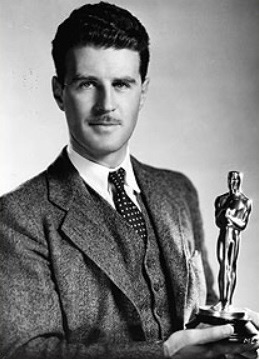Related Research Articles

The Academy of Motion Picture Arts and Sciences (AMPAS), often pronounced AM-pass; also known as simply the Academy or the Motion Picture Academy) is a professional honorary organization in Beverly Hills, California, U.S., with the stated goal of advancing the arts and sciences of motion pictures. The Academy's corporate management and general policies are overseen by a board of governors, which includes representatives from each of the craft branches.

Douglas Graham Shearer was a Canadian American pioneering sound designer and recording director who played a key role in the advancement of sound technology for motion pictures. The elder brother of actress Norma Shearer, he won seven Academy Awards for his work. In 2008, he was inducted into Canada's Walk of Fame.
The 6th Academy Awards were held on March 16, 1934, to honor films released between August 1, 1932 and December 31, 1933, at The Ambassador Hotel in Los Angeles, California. They were hosted by Will Rogers, who also presented the awards.

The 42nd Academy Awards were presented April 7, 1970, at the Dorothy Chandler Pavilion in Los Angeles, California. For the second year in a row, there was no official host. This was the first Academy Awards ceremony to be broadcast via satellite to an international audience, though outside North America, Mexico and Brazil were the only countries to broadcast the event live.
John O. Aalberg was a Hollywood sound technician who worked on films including Citizen Kane and It's a Wonderful Life. He was a ten-time Oscar nominee, and received three technical awards from the Academy.
The 36th Academy Awards, honoring the best in film for 1963, were held on April 13, 1964, hosted by Jack Lemmon at the Santa Monica Civic Auditorium in Santa Monica, California. This ceremony introduced the category for Best Sound Effects, with It's a Mad, Mad, Mad, Mad World being the first film to win the award.
The 34th Academy Awards, honoring the best in film for 1961, were held on April 9, 1962, hosted by Bob Hope at the Santa Monica Civic Auditorium in Santa Monica, California.

The 30th Academy Awards ceremony was held on March 26, 1958, to honor the best films of 1957.
Fred Sersen was an American painter and cinema special effects artist working mainly at 20th Century Fox Studios from the 1930s to the 1950s with credits in over 200 movies. He won two Academy Awards for Best Effects, Special Effects (photographic), in 1940 for The Rains Came, and in 1944 for Crash Dive. An artificial lake created for the former film was named in his honor.
Nathan Levinson was an American sound engineer. He won an Oscar in the category Sound Recording for the film Yankee Doodle Dandy and was nominated for 16 more in the same category. He was also nominated seven times in the category Best Special Effects.
Thomas T. Moulton was an American sound engineer. He won five Academy Awards in the category Sound Recording and was nominated for eleven more in the same category. He was also nominated four times in the category Best Visual Effects.
Edmund H. Hansen was an American sound engineer. He won two Academy Awards; one for Best Sound Recording and the other Best Visual Effects. He was nominated for another 12 films across the two categories.
Elmer R. Raguse was an American sound engineer mostly associated with the Hal Roach Studios. He was nominated for eight Academy Awards in the categories Best Sound Recording and Best Effects.
Loren L. Ryder was an American sound engineer. He won five Academy Awards and was nominated for twelve more in the categories Best Sound Recording and Best Effects.
Charles L. Lootens was an American sound engineer. He was nominated for four Academy Awards in the category Best Sound Recording.
Bernard B. Brown was an American sound engineer and composer, who wrote the scores for many early animated cartoons produced by Leon Schlesinger Productions for distribution by Warner Bros. Pictures. He won an Academy Award in the category Sound Recording and was nominated for seven more in the same category. He was also nominated three times in the category Best Visual Effects. He worked on more than 520 films between 1930 and 1958.
A. W. Watkins was an English sound engineer. He was nominated for four Academy Awards in the category Best Sound Recording.
Fred Hynes was an American sound engineer. He won five Academy Awards in the category Sound Recording and was nominated for two more in the same category.
Michael J. Kohut was an American audio engineer. He was a seven-time Academy Award nominee for Best Sound, a BAFTA award winner for Best Sound for Fame and was President of Post Production Facilities at Sony Pictures Studios. During his tenure at Sony Pictures Studios, he led the American team in the development of Sony Dynamic Digital Sound the discrete eight-channel playback system for motion picture sound.
Farciot Edouart, ASC was a film special-effects artist and innovator perhaps best known for his work with process photography, also known as rear projection.
References
- ↑ "The 12th Academy Awards (1940) Nominees and Winners". oscars.org. Retrieved June 16, 2013.